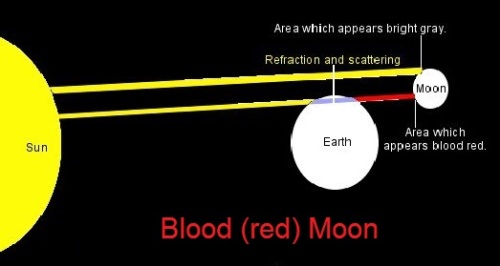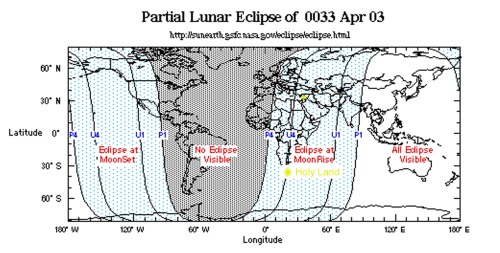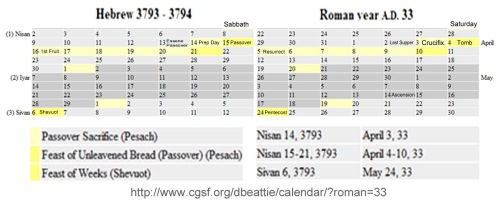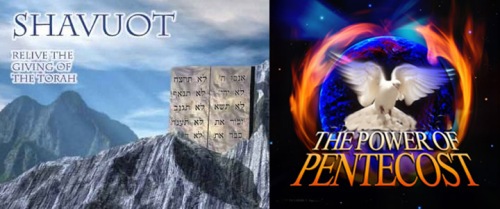There’s a bunch of evidence to put the day of Jesus’ crucifixion on April 3, 33 AD, or Nisan 14, 3794 in the Jewish calendar. For example, a Greek historian named Phlegon described the same events we read about in the Gospels — i.e., that the sun was eclipsed and there were earthquakes — and he dates it to 33 AD. Pontius Pilate wrote something even more specific in a report to Tiberius Caesar:
Now when he was crucified darkness came over all the world, the sun was altogether hidden, and the sky appeared dark while it was yet day, so that the stars were seen, though still they had their luster obscured, wherefore, I suppose your excellency is not unaware that in all the world they lighted their lamps from the sixth hour until evening. And the moon, which was like blood, did not shine all night long, although it was at the full. – Pontius Pilate, 33 AD
I don’t know what caused the sky to darken in the afternoon. A regular solar eclipse only lasts minutes, not hours, and is caused by the moon, which was in the wrong place. However, a blood moon is common during a lunar eclipse, which according to NASA occurred on April 3, 33 AD and was visible in the Holy Lands.
The only problem with accepting the 33 AD date is that the Synoptic Gospels all refer to the Last Supper as the “Passover feast.” We know that the Last Supper was on a Thursday, but in 33 AD, Nisan 14 was on Friday, not Thursday. When God set out the Jewish feasts, He told Moses:
The Passover of the LORD falls on the fourteenth day of the first month, at the evening twilight. -Lev 23:2
I looked up every year from 3788 through 3800; Nisan 14 just didn’t fall on a Thursday in any year within a reasonable span of the time we know Jesus died. Nisan 14 landed on 3788/Wednesday, 3789/Monday, 3790/Saturday, 3791/Wednesday, 3792/Wednesday, 3793/Monday, 3794/Friday, 3795/Wednesday, 3796/Monday, 3797/Friday, 3798/Wednesday, 3799/Monday, 3800/Monday. (The Hebrew/Roman calendar app URL is below.)
The Gospel of John presents another conundrum, in that it clearly says the Last Supper was on Nisan 13, the day before Passover, and that Jesus died on the cross even as the priests in the Temple were killing the lambs people needed for their Passover meals that evening. Nisan 14 is called Preparation Day, for obvious reasons.
In other words, John’s Gospel agrees with Phlegon, Pilate and NASA that Jesus was crucified on April 3, 33 AD. I love how that date works out in our calendar with our Bible number symbolism. The THIRD day of the FOURTH month is God plus Creation = Completeness. And two THREES for the year is like God the Father and God the Son together.
That just leaves us with the puzzling question of why the Synoptics ALL say the Last Supper on Nisan 13 was a Passover feast. Pope Benedict XVI explained it in his Holy Thursday homily in 2007. It seems that the Dead Sea Scrolls say that the Essene community celebrated a lamb-less Passover on the evening of the 13th. Neat, huh? Jesus was the Lamb at this meal during which He instituted the Holy Eucharist, giving us His Body and His Blood for all time.
The Essenes were an ascetic Jewish sect that practiced voluntary poverty. We would call them monks and, according to Josephus, a noted historian of the period, there were thousands of them throughout Roman Judea. Apparently, they expected the Messiah to arrive soon, so maybe it should not be surprising that they disappeared simultaneously with the rise of Christianity. It is speculated that most of them became Christians.
I think this fact explains the apparent contradiction between the Synoptic Gospels, which were written around 50 AD, and the Gospel of John, which was written a few decades later. People would’ve still been familiar with the Essene practices in 50 AD; some of them would’ve been former Essenes themselves. But by 80 AD, those references to a Passover feast on Nisan 13 would’ve had hands shooting up at every Bible study, especially among the Gentiles who would’ve been really clueless about the practices of an extinct Jewish sect. I think John knew there was a lot of confusion, so he wrote what he did in his Gospel to make it very, very clear that Jesus died on Preparation Day, Friday, Nisan 14.
The Passover feast starts off the week-long Feast of Unleavened Bread, which runs from Nisan 14 (sunset) until Nisan 21 (sunset). The 15th and 21st are holy rest days; that’s why they’re dark yellow on the calendar above. When Nisan 15 fell on Saturday, as it did in 33 AD, it was a High Sabbath.
Jesus was entombed throughout the High Sabbath of Nisan 15, 3794 (April 4, 33 AD).
In Leviticus 23, when God set the feast calendar for His people, He nested two special feasts within the week of Unleavened Bread – the Feast of Passover and the Feast of First Fruits. As I’ve explained, Passover always starts at sunset on Nisan 14, which means it floats around in the week from year to year. The Feast of First Fruits, however, is always on the day after the Sabbath (i.e., Sunday) that falls within the week of Unleavened Bread.
“You shall bring the first sheaf of your harvest to the priest, who shall elevate the sheaf before the LORD that it may be acceptable on your behalf. On the day after the Sabbath the priest shall do this.” Lev 23:10-11
In 33 AD, the first Easter Sunday, the day Jesus rose from the dead, was also the Feast of First Fruits.
“First fruits” was the portion of the harvest offered in thanksgiving to God. It implies the consecration of the entire harvest to come. Christ’s resurrection is not an end in itself; its finality lies in the whole harvest, ourselves. In 1 Cor 15, Paul goes into this idea, but I never knew before that the first Easter was literally the Jewish Feast of First Fruits!
But now Christ has been raised from the dead, the first fruits of those who have fallen asleep. For since death came through a human being, the resurrection of the dead came also through a human being. For just as in Adam all die, so too in Christ shall all be brought to life, but each one in proper order: Christ the first fruits; then, at his coming, those who belong to Christ.
Forty days after Easter, Jesus ascended into Heaven:
Jesus presented himself alive to them by many proofs after he had suffered, appearing to them during forty days and speaking about the kingdom of God. While meeting with them, he enjoined them not to depart from Jerusalem, but to wait for “the promise of the Father about which you have heard me speak; for John baptized with water, but in a few days you will be baptized with the holy Spirit. … You will receive power when the Holy Spirit comes upon you, and you will be my witnesses in Jerusalem, throughout Judea and Samaria, and to the ends of the earth.” When he had said this, as they were looking on, he was lifted up, and a cloud took him from their sight. Acts 1:3ff
Ten days after that:
When the time for Pentecost was fulfilled, they were all in one place together. And suddenly there came from the sky a noise like a strong driving wind, and it filled the entire house in which they were. Then there appeared to them tongues as of fire, which parted and came to rest on each one of them. And they were all filled with the holy Spirit and began to speak in different tongues, as the Spirit enabled them to proclaim. Acts 2:1ff
In the Jewish tradition, Pentecost is called the Feast of Weeks or Shavuot. It commemorates the day God gave the Torah to the entire nation of Israel assembled at Mount Sinai. Jesus said, “I have come not to abolish the Law, but to fulfill it.” And the Holy Spirit came on Shavuot. Now there’s something to meditate on!
Sources:
- http://www.cgsf.org/dbeattie/calendar/?roman=33
- http://www.usccb.org/bible/leviticus/23
- http://catholicknight.blogspot.com/2007/04/new-theory-explains-passover.html
- http://catholicknight.blogspot.com/2007/04/exact-date-of-christs-crucifixion.html
- http://www.zenit.org/article-19341?l=english
- http://en.wikipedia.org/wiki/Essenes
- http://bible-truth.org/Feasts-Firstfruit.html
- http://runholy.com/pilates-letter-to-caesar/














Plenty of good work here to keep this rocket scientist fascinated. Really like the eclipse analysis. Me and my old man used to spend lots of time arguing about some of the Biblical miracles that seemed to have quasi-natural origins, such as the plagues of Egypt, or the loaves and fishes. His view was that they were generally all natural phenomena, but the timing was supernatural. I’m not so sure. Many of the modern miracles that have occurred (during apparitions, for example, at Lourdes or Garabandal) seem to be a puzzling mixture of natural events with certain natural laws briefly but clearly violated. Gravity gets violated a lot. Perhaps the blood moon itself was natural, but timed supernaturally and extended with a solar eclipse bonus? Truly mysterious.
LikeLike
My personal faves for stump the skeptics miracles are Guadalupe and Lanciano. Both involve historically documented and scientifically tested objects that still exist, so there’s no dependence on historical reports (e.g., sun miracle at Fatima) or psychosomatic or natural remission folderol.
LikeLike
It was discussed here, wasn’t it, that Hillary Clinton, at the Church of Our Lady of Guadalupe, standing there looking at it, asked who was the painter? Still jaw-dropping. (Ah, I can still write a shorter comment!)
LikeLike
TRULY jaw dropping. And then she went outside and told the peasants waiting to view Her Specialness, “You’ve got a nice virgin.” ::facepalm::
LikeLike
Good point, although even at Fatima, there were photos in European newspapers at the time, but they required interpretation.
LikeLike
I think you misunderstood my point. There were hundreds of people who saw the miracle of the sun at Fatima, but NOW, all we have are historical records of what they say they saw. I find skeptics just scoff at anything like that … unless it happens to support some whacky theory they hold to be true – e.g., evolution. LOL
LikeLike
True! I stand (sit) corrected. 🙂
LikeLike
“generally all natural phenomena, but the timing was supernatural.”
Grunt: Practically every “miracle” I’ve ever experienced or heard of has been perfectly explainable as “fortuitous coincidence” or “ordinary circumstances” (even if the explanation did require a bit of a stretch sometimes.) One “just happened” to meet that certain person, find that book, take that detour. Almost seems like such things were built into the system from the beginning of time…! (Which is why I always say, appreciate the detours and delays.)
God isn’t blaring with trumpets saying, “I did this!”
When Jesus healed, he always emphasized “your faith,” not his power. It even happened without his conscious assent. He didn’t do it to show off or impress; we can understand, so I know he did, how wonders may make temporary believers out of the weak and gullible, but they don’t inspire true faith. And let’s face it, the most astonishing physics-defying miracle can be explained away if skeptics want to. Jesus wasn’t really dead on the cross, you know, ’cause, usually, it took about three days to die on a cross, so the guys that took his body took him away for healing, and that’s why the tomb was empty… (etc).
That said, two examples come to mind of Jesus’ wonder-working that were intentional and for “show” and how that worked out:
One, feeding 5000. That amazing work caused the masses to call for him to be king, and when he refused, you can bet at least four thousand forgot about him, because he wouldn’t be what they wanted him to be. So much for the holding power of a miraculously filled belly.
The other, healing the blind man. Unasked for, out of the blue, and not in response to faith. Again, though, not to show off or to “make believers out of people.” The blind man had a purpose, bringing Jesus’ final offer of mercy to the Jewish leaders. He is for me one of the most inspiring people in the Bible. “I told you already and you didn’t listen. Why do you want to hear it again? Do you want to become his disciples too? … If this man were not from God, he could do nothing.” The meerest of the mere testifying before the learned and powerful.
Eek! I’ve run off at the keyboard again. Sorry And I really started out to answer Chrissy’s post. Guess I’ll take another slot. Charge my account.
LikeLike
See if I can keep this shorter. (Turns out, nope.)
It was not Passover. It was just supper the day before, as your calculations correctly demonstrate. Very nice work! A special supper, to be sure, but not Passover. Jesus understood he was going to be busy the next day and wouldn’t be partaking of Passover with his friends. The clueless eleven didn’t know it was their last supper with their Master, though; but they wouldn’t’ve thought a thing about it being meatless.
Those who need to reconcile scripture with scripture because they believe it’s all perfect, just look away now. Gone? Okay. Please understand, I mean no disrespect here. I revere and appreciate the Gospels which taught me to love and follow Jesus all my life, but I have no problem seeing the bugs in the Bible (and I don’t mean the locusts).
The synoptics have a problem which those of us who use computers can appreciate. If you cut-and-paste what’s right, you get a perfect copy. If you cut-and-paste what’s erroneous, you get a perfect copy… of the error. The authors of Matthew 26:17-18 and Luke 22:7-13 presumably copied directly from copies of the earlier Mark 14:12-16. Copied quite well, and I’m not questioning the sincerity of any of those scribes involved. By the time John’s Gospel was written, John’s authors surely had copies of the earlier Gospels, and John 13:1 sets the record straight. A further fat clue, to which you alluded, is John 19:42, the crucifixion “was the Jewish day of Preparation,” which is why the menfolk did a hasty job on the burial, which caused the women to try to go out to the tomb to do the job right the next day.
(If I seem to err in my understanding or scripture reading, beside the inerrancy thing I mean, someone let this hasty-speaking armchair bloviator know, all right?)
The values of the Last Supper are undiminished because MM&L have a technical glitch; John’s clarifying bug fix causes me no stress. Just as, if there is confusion over whether there were one, three, or no angels or shiny-clothed men at the empty tomb, it changes nothing about the eternally-enduring value of Mary’s testimony of speaking with the risen Master. I can’t read or even think of him saying her name without weeping.
Dear Fundamentalists, for expressing my heathen attitude, I shall go lash myself twenty times with a wet noodle. Thanks, Chrissy, for driving me into the Gospels. Sometimes I get busy and forget to take the time to refresh.
LikeLike
Loved your additions! 🙂 I actually had never noticed before the difference between the Synoptics and John on the date of Passover. I’m guessing it is one of those things that atheists put in their books of “Why Christians are stupid to believe the Bible.”
Personally, I think the discrepancies ADD to the veracity of the Bible. It’s messy … the way real life is. Witnesses after a crime don’t report the same things. Plus, if it were a faked up book, like Barack Obama’s Life Story, then stuff like David and Bathsheba would’ve been scrubbed. KWIM?
In my researches, I came across the 33 AD historical references and NASA thing first. I had no problem swallowing the date without further condiments, simply because I love symbolism and so was immediately enamored of the FOURTH month, THIRD day, THREE THREE year.
My confusion went in another direction actually. I thought the Last Supper was THE Passover feast, but the calendar for 33 AD clearly showed Nisan 14 to be Good Friday. Then I read John’s account, which had the goosebumpingly intense image of Jesus dying while the priests were slaughtering the lambs.
At first, I just figured, “So what?” Matthew, Mark and Luke may or may not have considered what would be their Last Supper with Jesus as a Seder (Passover feast), AT THE TIME. But I’m fairly sure they did not eat a traditional Passover feast the next evening after they buried their Lord. Who would’ve had the appetite? It would’ve been understandable if they had just started calling the Last Supper their Passover feast, since it had been the only one they had celebrated.
We’ve always been flexible about dates for holiday things. We start calling around weeks before big holidays to coordinate when everyone’s inlaws are gathering with when would be best for us to gather, check Mass schedules, flights, yada yada. So Big Deal if “Thanksgiving Dinner” happens once on Thanksgiving Thursday or two or three or four times with different groups of loved ones? As far as I’m concerned, that’s all Thanksgiving.
So suppose I could say, “We were just finishing up Thanksgiving when yada happened,” and some calendar geek goes, “Whoa, Nellie, THAT didn’t happen on the fourth Thursday. You’re a LIAR.” No. I’m just flexible with holidays and also not into wasting your time explaining why we were celebrating Thanksgiving that particular day.
Then I found the Pope’s thing about the Essenes, which I thought was fascinating. It cast a new light on the Synoptics, so I deleted my “flexible about holidays” paragraphs and rewrote that whole section of the blog.
Re: John clarifying. I did a Bible study once about the “woman anointing Jesus’ feet/hair” incidents and found that John had done a similar “clarifying the Synoptics” thing when he wrote. If you’re interested, I can dig it out and reformat it for WordPress. It’s really interesting.
LikeLike
Yes, good stuff, Mindful!
LikeLike
I always assumed the Last Supper was not the Passover, based on the fact that Jesus and the disciples were said to be reclining at the table. If I remember correctly, the Passover was consumed standing up (at least that’s how God told them to do it).
LikeLike
Now you’re going to force me to go look that up, Bob. Geez, I’m trying to be a passive, blob-like Christian. This is outside my comfort zone.
LikeLike
Yeah, I’m kind of a pain in the petunias like that.
LikeLike
Oh yeah! I forgot that.
LikeLike
All very, very interesting, including Grunt’s and Mindful’s contributions! I got a kick out of he “cut and paste” analogy Mindful used. If I remember correctly, there is one other source which is thought to be common to both Matthew and Luke, but not from Mark. I think this source is called “Q” by scholars.
There is a very funny, but lovingly irreverant novel that I thoroughly enjoyed some years back. It is out of print, but you can find a used copy from time to time on Amazon. “Gospel” by Wilson Barnhardt. It is a modern tale of a defrocked priest (who is a university professor) and his young female graduate student as they travel all over the world in an attempt to locate a manuscript which is said to be the Gospel of “somebody I can’t remember – maybe Matthias”. Matthias(?) is the older brother of the historian Josephus, and his gospel is a letter to Josephus describing the last days of the life of Jesus. If this entry of Chrissy’s interests you, you really might enjoy that novel. It is in one of my top ten favorite books.
LikeLike
All I can say is that it is kind of like the telephone game. By the time it gets to the end of the line, the story can change-especially by those who would intentionally do so.
Since we know that the bible was actually written long after events happened, we can assume that some stories have changed.
That is why I have never been able to take the Bible literally. I believe it is a book of lessons we need to learn, because they are the best guide to living a purposeful life.
I know that some of my more religious friends here will disagree with me, but that is okay.
Faith has many aspects. I do not believe there is one way that is THE way. But for all of us,
In the end.
It is just about faith in God.
LikeLike
I’m not a literalist when it comes to understanding the Bible. I saw a cartoon many, many years ago — I wish I had it now — that showed what the woman in The Song of Solomon would look like if Solomon’s description of her were taken literally, and it was absolutely hilarious.
LikeLike
Okay, I did a search and found this one — it’s not the same one I saw 30+ years ago, but it’s the same general idea.

LikeLike
Sorry, that got sort of cut off. See it full size here.
LikeLike
That’s pretty funny. You had me worried for a second, there. I thought at first that this was one of your teen daughter’s drawings and she was going through an LSD experimentation phase. 😯
LikeLike
The style is somewhat similar to hers, isn’t it? I have no idea who drew it — it just popped up on a google search. (No telling what you may find when you start googling books of the Bible!)
LikeLike
ROFLLLLL the flock of goats ROFLLLLL snort
LikeLike
I saw a toon recently of Jesus saying to his disciples, “Now listen carefully, because I don’t want to end up with four versions of this stuff.”
LikeLike
Tee-hee 🙂 … I’m sure there were more than four versions (probably eleven, I’d guess)… but only four of them survived and made it into the canon. I guess we’re lucky it’s not more!
LikeLike
The history of the canon is interesting.
Click to access Criteria%20for%20Development%20of%20the%20NT%20Canon%20in%20First%20Four%20Centuries.pdf
I found a list of non-canonical gospels here
http://wesley.nnu.edu/sermons-essays-books/noncanonical-literature/noncanonical-literature-gospels/
LikeLike
I think I see what you’re saying here GP, and Bob as well about not being strict literalists, and I agree in the sense that much of the Bible is poetic or instructive or in the form of parables. But I hesitate to make such sweeping generalizations about it. Clearly, much of both Testaments is about historical events and people who actually walked the earth, even if some would dispute it. Isn’t it important to allow for that? Isn’t it both? I think I would view my faith much differently (i.e., I would have none) if it turned out that Christ had not been a real person. I was just thumbing through The Shadowlands of C.S. Lewis yesterday, and caught part of what he wrote about this kind of thing. He was quite adamant that certain things must be taken quite literally. For example, either Jesus is actually the Son of God as he claimed, or he was a madman. There is really no other sensical explanation.
LikeLike
Oh, I believe that Christ was a real person, and that He was who He said He was — I don’t question that at all. When I said I wasn’t a literalist, I was thinking less about the historical books, more about the poetic and prophetic ones, which are full of all kinds of symbolic language that I don’t think was intended to be taken literally. When Isaiah talks about the trees of the field clapping their hands, I don’t think he meant it literally. Even Jesus employed symbolic language to make His points — calling himself a lamb, a door, a vine, etc.
LikeLike
Oh, good! I believe you, and I totally agree.
There are lots of places where Jesus words, especially, are very difficult to interpret, literally or otherwise. Sometimes it’s a matter of not quite understanding the context or the “larger view.” I was always confounded by that part in the Gospels where Jesus tells Peter “Get behind me, Satan.” It occurred to me the other day that maybe he’s not talking to Peter at all? Maybe we’ve just always been so materialistic in our thinking that we assume that, but in a more spiritual time, it might not have been so strange to think that Satan, himself, was in the room and took the occasion of Peter’s words to tempt Christ?
LikeLike
But I don’t think anyone will agree with that crazy interpretation. That was probably a revelation during one of our Thursday night poker and drinking game bonanza Bible studies. 😀
LikeLike
I don’t think Jesus was talking to Peter; He was talking to Satan. Satan was using Peter’s words to try to distract Jesus away from what He knew He was supposed to do. Jesus was telling him to get lost.
LikeLike
No way! You think so, too? How come I’ve never heard that interp from anybody before? In the sermons, they always say that the word “satan” means “adversary” and so it just means that Peter is being an adversary to Jesus, but I don’t buy it. We should be theologians, Bob. Start our own church, maybe. 🙂
LikeLike
I don’t think I’ve ever heard that “satan” = “adversary” before. It’s plausible, I guess, and I’m no linguist — not when it comes to Aramaic, anyway. I took a couple of semesters of New Testament Greek, on the fanciful notion that I would master it to the point where I could read the NT in Greek (didn’t happen). My opinion was just based on what I know about spiritual warfare, some of which I know from experience, but much of which I learned from reading the works of C. S. Lewis — especially the Narnia books, The Great Divorce, Out of the Silent Planet, Perelandra, and That Hideous Strength.
LikeLike
Awesome! Lewis’ Screwtape Letters is also very good when it comes to spiritual warfare.
LikeLike
Oh, yeah, that too — I knew I was forgetting something!
LikeLike
“either Jesus is actually the Son of God as he claimed, or he was a madman. There is really no other sensical explanation.”
Wow. I didn’t know CS wrote that. When I read the Gospels all together for the first time as an adult, I came away utterly convinced of Jesus’ historicity — nobody could have made him up, he was just too far beyond anybody of the time, including the folks who wrote about him. And I was utterly convinced that he said and believed what he said about his pre- and post-human life, “before Abraham was, I AM,” and coming from and returning to the Father. That was just too integral a part of the whole story, said too frequently, and, especially, the real basis of his trial before the Sanhedrin, to think he never said it. So, he meant it, not metaphorically or mystically, but literally.
That kind of puts the challenge to my practical, skeptical sensibilities. Either he was the wisest guy in history, with a certain mad streak that you have to ignore, or he was consistently sane… and the Son of God, incarnate.
I had no real choice but to go with consistently sane.
As I digested that truth, I never really expected to find out more about exactly what being the “Son of God” meant, but I have never since questioned that he was.
LikeLike
“bible was actually written long after events….”
Cassels makes the point that scraps found among the Dead Sea Scrolls are fragments of Mark, dated to AD50. “Until this discovery was made, biblical scholars had assumed that Mark’s gospel — evidently the oldest of the four contained in the New Testament — had been written in Rome between AD 65 and 68. … But if Mark’s gospel were written within a dozen or so years of Jesus’ death… then it had to survive the acid test of all historical writing or journalism: namely, being published at a time when it could be read, criticized and, if inauthentic, denounced by people who were alive and present at the time the alleged events occurred.” That fact of people still alive who lived through and witnessed events selecting the texts is something folks 2000 years later sometimes neglect to take into account. “Jesus’ original followers found Mark’s report to be accurate and trustworthy — not myth, but true history.” [Emphasis mine.]
Even John, while likely written by one of his followers, was written while John was still around to be Chief Editor (or, as Cassels puts it, “within the probable lifetime of the Apostle whose name it bears”), and even if “the apostle whom Jesus loved” was getting dodgey in his old age, I think we can largely trust in that.
Ahem, having said that, Cassels warns, “John is inclined to attribute to Jesus words and thoughts that almost certainly represent John’s own views of what Jesus meant to say, or would have said in a particular circumstance. Since direct quotes are not used in the Greek manuscripts of the Gospels, it is hard to tell where Jesus’ actual words leave off and John’s interpretations of them begin. This need not cause any serious hangups for the modern reader.”
LikeLike
I was going to mention “Q” but I had abused up my word quota. 🙂
Cassels (boy, this book is falling apart!): “Matthew seems to have had available a collection of Jesus’ teachings and sayings — perhaps from the famous ‘Q ‘ document which scholars have long postulated but so far have not been able to find. Luke had ‘Q’ — or whatever it was….”
Wikipedia: “Q was conceived as the most likely explanation behind the common material (mostly sayings) found in the Gospel of Matthew and the Gospel of Luke but not in Mark.” Also: “Some of the more notable portions of the New Testament are believed to have originated in Q…” including the beatitudes. Huh. I can still learn sumpin’!
http://en.wikipedia.org/wiki/Q_gospel
LikeLike
Not to be confused with the Q of Star Trek fame. ;o)
LikeLike
Chrissy, on more clue. Cassels (can you tell I’m enjoying revisiting him?) talks about “a cryptic passage in the Talmud which speaks of [Jesus] having been put to death ‘on the eve of the Passover.'” The Passover “Day” began at sunset, right? So the eve of would be that Friday before sunset.
LikeLike